You may have heard of Death Road. It’s been featured in a Top Gear special, and has spawned a number of slightly hysterical Daily Mail articles (http://www.dailymail.co.uk/travel/article-2729754/A-15-000ft-descent-sheer-drops-300-deaths-year-Welcome-Bolivia-s-Death-Road-terrifying-route-tourists-love-cycle.html , http://www.dailymail.co.uk/news/article-2381858/Cyclists-brave-700-metre-drops-Bolivias-North-Yungas-Road-aka-worlds-deadliest-road.html ). It’s real name is the Yungas Road, connecting La Paz to some slightly smaller towns to the North, and it was built by Paraguayan prisoners in the 1930s. It gets it’s name, predictably, because lots of people have died while travelling down it.
In 2008, the top part of the road was closed to cars, after a new, much safer bypass was opened. Since then, it’s pretty much only bikes that use it. Loads and loads of bikes. It forms a 64km mountain bike trail, starting outside La Paz at 4200m, and finishing in a town called Coroico at 1000m. After incessant pressure from numerous La Paz tour companies, I gave in and agreed to cycle down it on a chunky mountain bike.
The first part of the day was spent getting kitted out ready to tackle ‘Death Road’. As you can see, it was quite extensive. You get a huge helmet, knee pads, elbow pads, jacket, trousers, etc. As somebody who doesn’t normally wear a bike helmet (for good reasons which I’m willing to defend), it seemed a bit much. But as the road is literally called Death Road, I figured it was best not to argue. I managed to negotiate down to a normal bike helmet rather than the Moto GP version you can see everyone else wearing, but that was it.
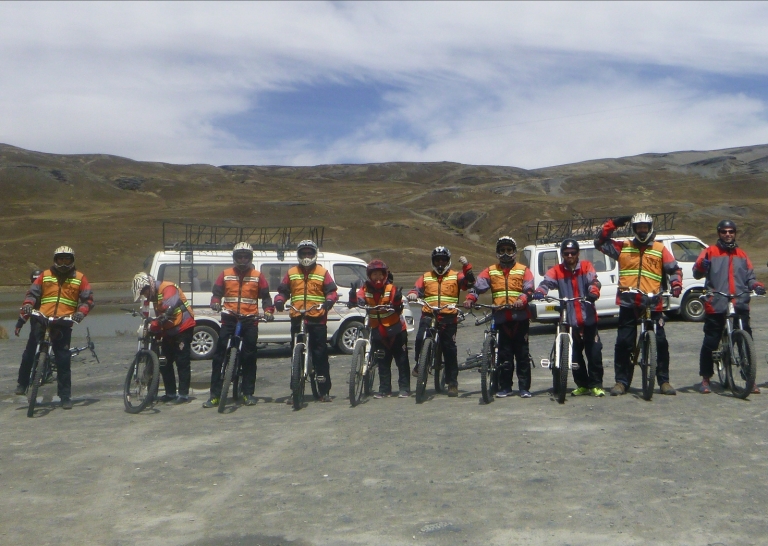
To be fair it was slightly chilly at the top so having the extra clothes wasn’t completely unwelcome. The first part is about 10km downhill, on lovely smooth tarmac, just to get to the start of actual Death Road. This bit is certainly not scary, and would be quite fun if you were on a road bike. On a stodgy mountain bike, it’s very frustrating. There’s so much friction that you never really go fast enough for it to be fun. The scenery’s great though, and I spent more time looking at the mountains than concentrating on the bike.
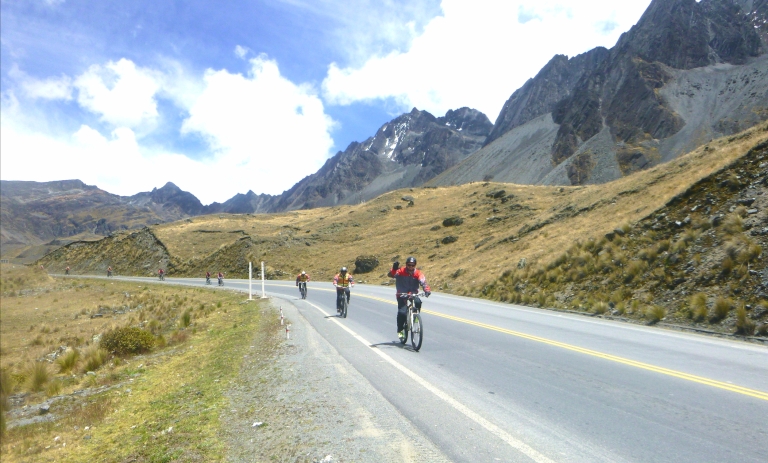
After a while you get to the start of the ‘scary’ bit. Interestingly, it’s the only road in Bolivia where you’re required to drive/ride on the left hand side of the road. This is the view from the top.
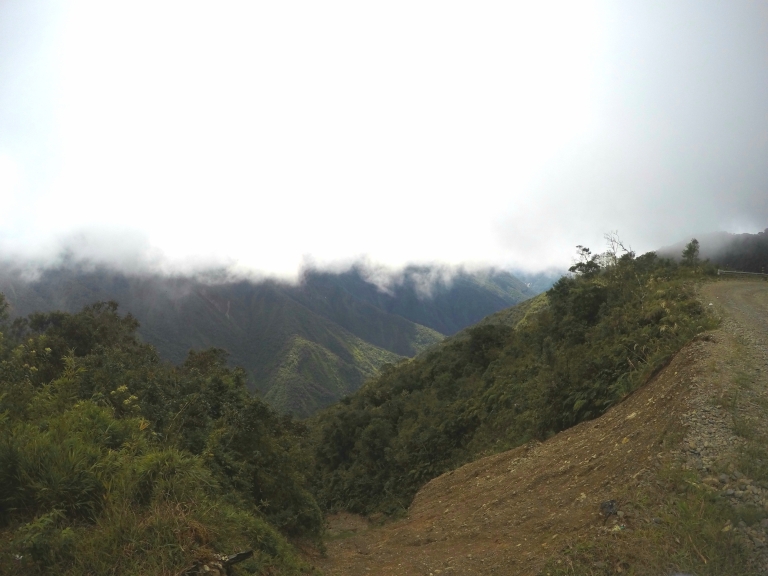
Everyone seemed a bit nervous. I’ve not done much mountain biking before and so didn’t know what to expect. The surface is pretty bumpy, and was basically just lots of loose stones. The intimidating bit (that’s taken so many lives) is the 300/400m drop on one side, for the whole way down the trail. Obviously, don’t want to fall down there. But at the start, we went so slowly, that there was little chance of that happening. Fair enough, good for everyone to find their feet, but not exactly the thrill ride I’d been expecting. It was fine, and cool to be doing it in such incredible surroundings.
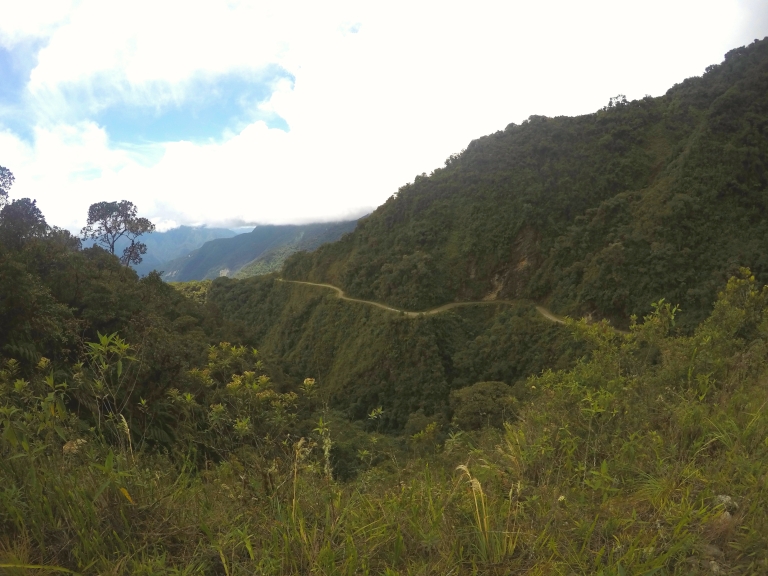
We started to speed up a little as we went, I think mostly because I kept saying ‘muy rapido’ to the guide every time we stopped. And boy did we stop often. The tour companies wanted to give tourists what they wanted. And seemingly what they wanted was photos. Lots and lots of photos. There are lots of cool places to take them, but the sheer number of stops and the insipid, repetitive nature of the shots made it a frustrating experience. There were lots of groups doing the same route, all stopping at the same places, taking the same photos, trying to make it look like they were the only ones on the whole road. It felt like a conveyer belt, where everyone gets the photo that proves they’re having the time of their life, before being ushered on so the next person with 300 bolivianos to rub together can do exactly the same thing. I’d be a hypocrite if I said I completely objected to this kind of photo taking, after all, Evie and I have taken hundreds of photos during our trip, many of which I’m sure give a overly positive impression of what’s going on. It just felt a bit sad that for lots of people, the goal of the day was to get the perfect picture (with them in it of course) and not really to enjoy the experience. This has been the case at quite a few of the places we’ve visited, not just Death Road. “Pics or it didn’t happen”. Eugh.
After our photo taking frenzy had calmed down a bit, things started to improve. Basically because the guides swapped, and the new one was prepared to go faster. As far as I’m concerned, adding a little bit of risk exponentially increased the fun. Adrenaline started to flow. Our group started engaging in a bit of unspoken but definitely real competition to ride in second place behind the guide, who it had always been assumed had to go at the front. Then, with about 10km to go, some middle aged Frenchman burst forward through the field, straight past the guide. I, sitting comfortably in second place, was outraged. That’s against the rules. He can’t do that. I could feel the tears welling up and was about to tell the teacher (the guide), when I remembered that: a) I’m 25 years old, b) I’m not at school, c) I’m paying for the privelige of doing this and d) I can’t speak Spanish anyway. The guide didn’t seem to care, so I zipped past him and went off in pursuit of the French guy.
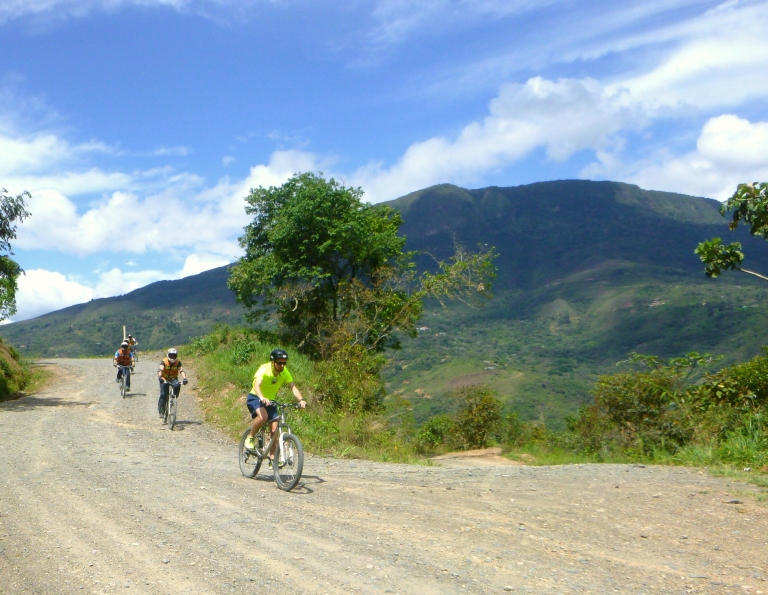
Free from having to stick behind somebody else, downhill mountain biking became SO much more fun. It’s pretty simple, you just have to pedal hard, avoid any stones that will be big enough to throw you off the bike, and not let go of the handlebars. I don’t know how fast I went but it felt fast. Just for this 10km alone, I think it was worth it, and if you’re ever in Bolivia, you should definitely do it. The day finished off with beers in a pool in Coroico, which was unsurprisingly great.
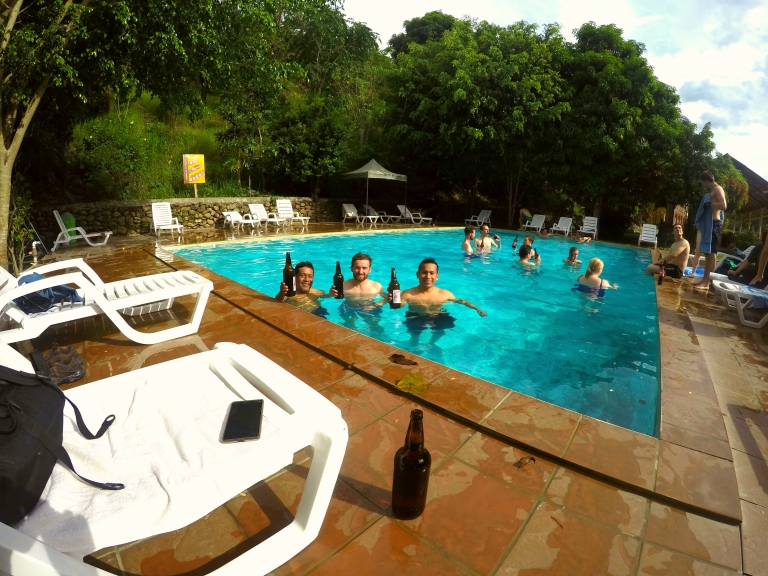
Did it live up to it’s name? Not really. No deaths, and it never felt very likely. Was it worth doing? Yeah.
That wasn’t to be our only encounter with Death Road, however. While you can’t drive along the top part any longer, you can still drive along the rest of it. In fact, if you want to go north up to the Amazon, you basically have to. Either that or flying. Evie & I wanted to go there, and are also cheapskates, so one Tuesday afternoon we found ourselves boarding this bus (below) to Rurrenabaque. We’d read a lot of things online saying it was the worst bus journey ever, and v dangerous, but we (I) felt it couldn’t be that bad.
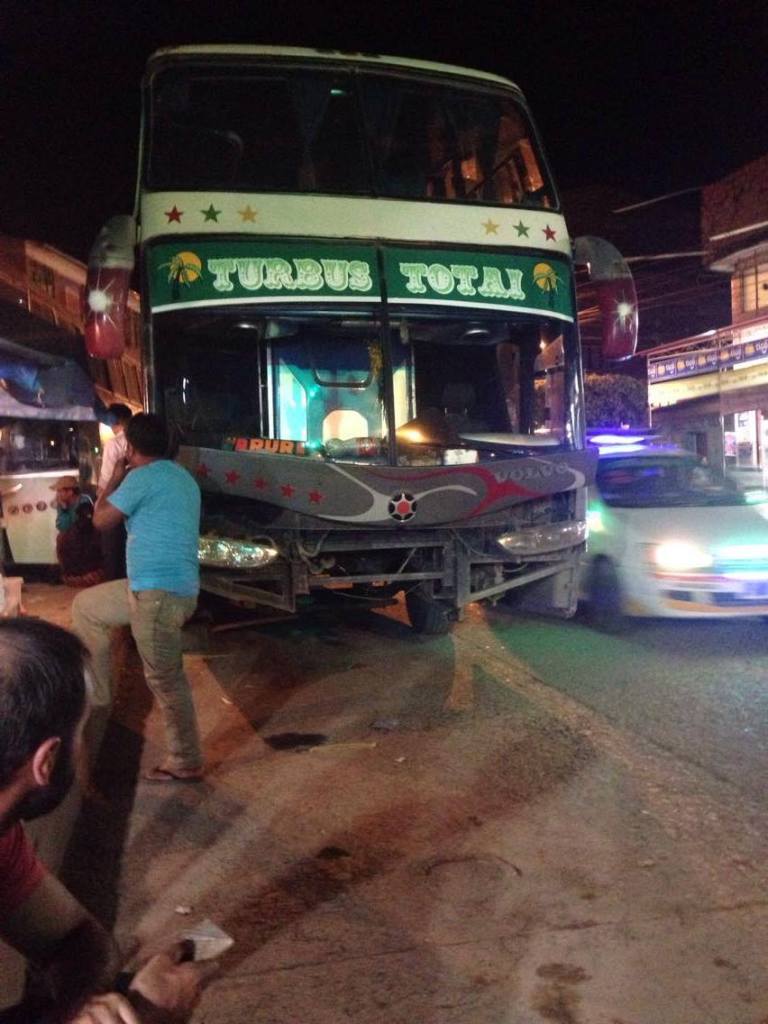
For the most part it was OK. But some parts were absolutely awful. The lower part of Death Road is basically the same as the upper part, but apart from being a 300/400m drop to your death, it’s more like a 150/200m drop to your death. Much better. The worst part is that in the most dangerous places the road is generally single track, and the surface leaves a lot to be desired. So if there’s someone coming the other way, one of you has to reverse until you find a passing place. I’m very familiar with this from driving in sunken Cornish country lanes. It’s very different when there’s a 200m drop on one side, you’re in a battered 50 seater bus being driven by a battered 50 year old driver (in case he inexplicably finds and reads this I should point out that he probably wasn’t drunk and had the complexion of a 43 year old). At one stage, we were reversing around a corner, part of which seemed to have been lost in a recent landslide. I’m sure that for a few seconds one of the wheels was overhanging the cliff.
And I thought at that point; it is very possible that we could die. If this bus went over the edge, we were gone. How many seconds would we have? Maybe 3 or 4. Not very long to get your affairs in order. It was starting to get dark, and for the rest of the journey this kind of thing was happening, we just weren’t aware because we couldn’t see anything. Oddly this was preferable. By far the worst part was seeing us inch ever closer, backwards, to oblivion. But it was still a very uncomfortable, and thought provoking, few hours. Obviously we survived, and I’m sure the bus drivers deal with those situations dozens of times on every journey and are always fine (at least that’s what I reassuringly told Evie).
I think the reason the experience in the bus was so much worse than the cycling was because of who was in control. The external environment was basically the same (massive deadly drop). But when I cycled, I trusted myself to not fall off, and to not cycle close enough to the edge that I might go over it. When you’re just sitting like a (sweating) lemon on a bus teetering on the edge, that control is taken away from you. If he’s rubbish at reversing and puts his left hand down when he should put it up, or stalls at the wrong moment, you’re dead. You’re not in control of your destiny.
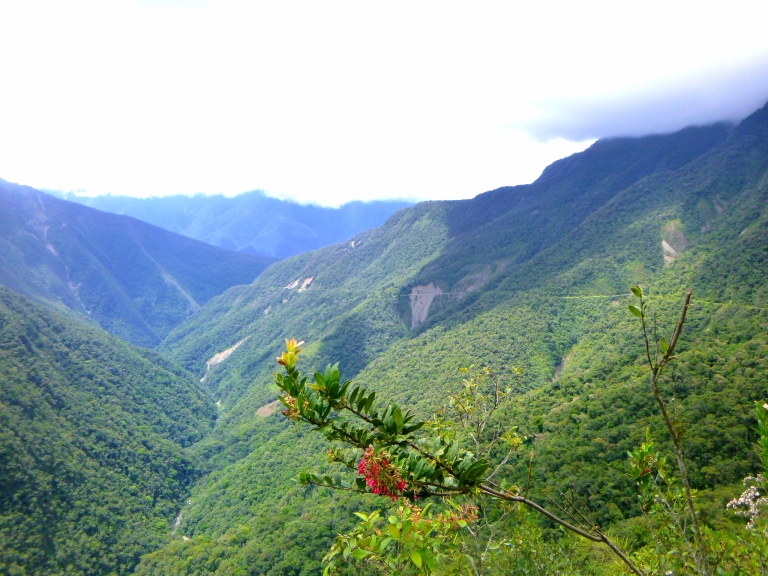
I guess that’s why people don’t think about death very often. It’s rare that we’re in the position of essentially putting our life in someone else’s hands. I don’t think about death on a day to day basis because I know I’m not going to die that day. I won’t do anything risky enough for death to be a likely outcome. But clearly we’re in much less control than we think, and all the time people die because of things that were nothing to do with them, but just happened. The people going to bed in Grenfell Tower on 14th June 2017. The middle aged man having a heart attack on the squash court. The 100+ people who plunged over the side of Death Road in a bus in 1983…
Something I occasionally think when I’m driving, particuarly on fast country roads, is that every time I pass a car going in the opposite direction, my life is in his hands. If he flicks his steering wheel a quarter turn to the right, a 140mph collision will leave us both dead. Even if he just isn’t concentrating on the road. And it’s the same with every car you pass. It’s not a helpful thing to think, particularly if you’re a nervous driver. But it is true. We’re in much less control than we think.
I don’t know how you’d react if someone told you you’d die in an hour. How would it feel? Not really enough time to do anything. Are you ready for what comes next? For me, I trust that there is something that comes next. Not because I’m particularly enlightened, or have worked it all out. I just trust in Jesus. I trust that he is who he says he was, and that what he says about life after death, about heaven and hell, is true. For example, Jesus says in John 6:40 ‘”For my Father’s will is that everyone who looks to the Son and believes in him shall have eternal life, and I will raise them up at the last day.”‘ I think there are good reasons to believe him, which I’m happy to share with you. I trust that he beat death by dying on the cross and being raised back to life, and that that wins life everlasting for those who are prepared to side with him.
Sometimes people ask me if I’m 100% sure I’m going to heaven. It’s normally a trick question. To say yes is to claim arrogant levels of certainty (and probably to lie). To say no is to doubt your faith. The Bible can’t be unequivocally proven, just as I can’t unequivocally prove that my parents love me. But I do trust that it’s true, based on experience, and the evidence available.
Did it stop me from feeling scared during the bus ride? Not completely. Death is still sad, and still a bad thing. Jesus weeps when confronted by the death of his friend, even though he’s about to raise him back to life (John 11:1-44). To die at 25, a month into marriage, never having the chance to raise a family, or enjoy a career, or whatever else life has to offer, would be sad. I was scared of missing out, and leaving things behind. But I think, if it had happened, I was ready.
1 Corinthians 15:54-57 ‘When the perishable has been clothed with the imperishable, and the mortal with immortality, then the saying that is written will come true: “Death has been swallowed up in victory.”“Where, O death, is your victory? Where, O death, is your sting?” The sting of death is sin, and the power of sin is the law. 57 But thanks be to God! He gives us the victory through our Lord Jesus Christ.’






